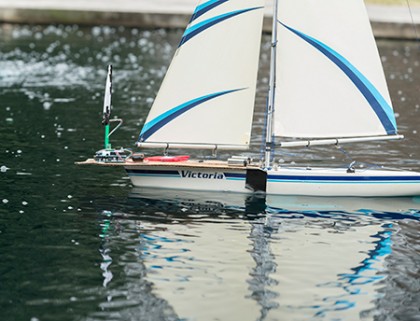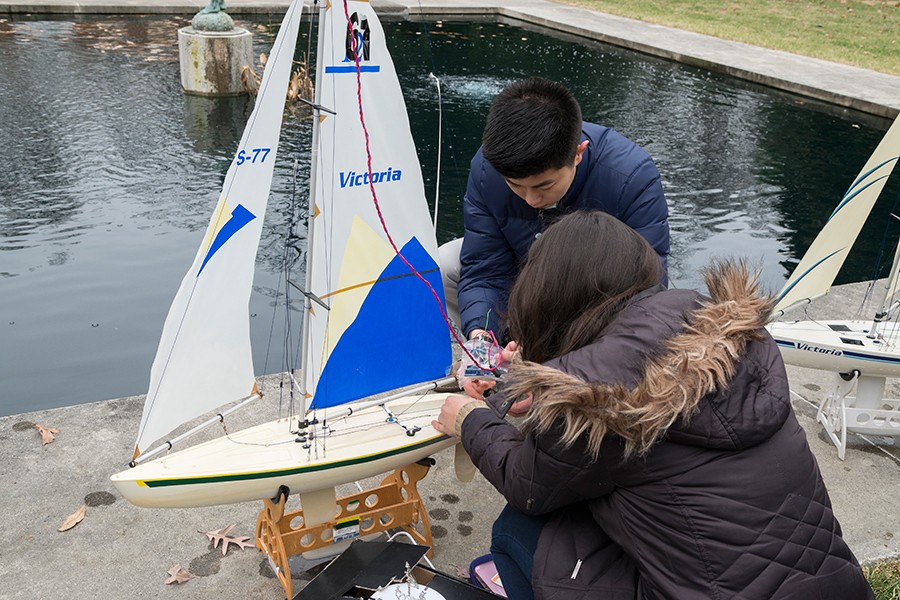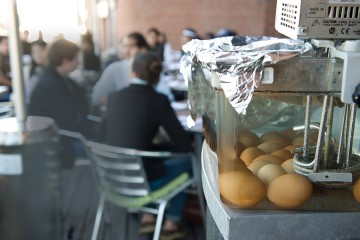On a cold, blustery day earlier this week—hardly an ideal day for a regatta—a few dozen Johns Hopkins University engineering students showed up at the fountain in front of President Ronald J. Daniels' residence, the Nichols House, to assist in wirelessly steering miniature, robotic sailboats in a stiff December wind.

Image credit: Jon Christoferson
"This is what you call a sink or swim assignment," quipped Gabriel Deards, a master's level student studying biomedical engineering.
The university's first such regatta was the brainchild of David R. B. Kraemer, associate teaching professor of mechanical engineering, as a final project for the upper-level Robotic Sensors and Actuators course. Final assignments in recent years have required students to produce the perfect piece of toast and design a blinking Halloween candy bowl.
"This is considered the toolbox for robotics," says Kraemer, himself a skilled sailor. "These projects require students to use everything they've learned in the lab, and then apply those lessons to a situation that they are not familiar with."
This year's challenge: Use sensors, actuators, and microcontrollers to create a device to make remote sailing easier. The class teamed up with the Black Swan Yacht Club, a group of retirees who race remote-controlled sailboats on a lake at Charlestown, a retirement community in Baltimore County. Specifically, students needed to use sensors to gather information about wind direction and boat orientation, then transmit that data wirelessly to a device that would display this information onshore for sailors. Students were given a budget of $25 to spend, and they were also permitted to borrow equipment from their laboratory.
On race day, as winds picked up, Kraemer assembled the teams. The first team out: smooth sailing. But for the next team up, things didn't go so swimmingly. A top-heavy sensor made the sailboat capsize quickly.
Juniors Nicole Ortega and Minjea Jo fiddled with their device, which was up next. Ortega, a veteran of the Locomotion in Mechanical and Biological Systems (LIMBS) laboratory, and Jo, a member of the Hopkins Baja club, used their design experience to come up with a mechanical system that displayed the boat's direction. A small wire boat—oriented to true north and spinning on a stationary disk—operated like a weather vane to show the boat's direction.
The team affixed a magnetometer (an electronic compass) to the top of the sail to gather information about wind direction and used an Arduino microcontroller to collect data on boat position. These devices transmitted data wirelessly to a computer and plastic disk that displayed information about wind direction and boat position, respectively. It worked. The disk spun as Kraemer steered the boat around the fountain. Meanwhile the computer displayed the wind direction. The sailboat took a tour of the fountain.
While the assignment looked like fun and games, it combined difficult programming skills learned throughout the semester.
"Debugging was a big challenge. We had issues getting the compass to read correctly, and spent a lot of time fixing the problem," Jo said. "It was frustrating, but at the same time, it's rewarding to see your system work well in the end."
Posted in Science+Technology, Student Life
Tagged mechanical engineering, robotics









